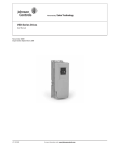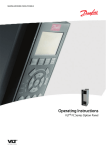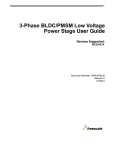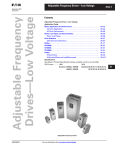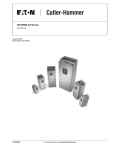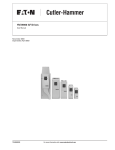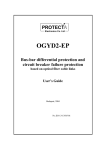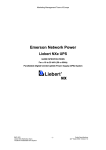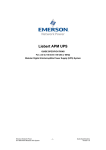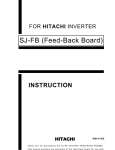Download VSD Series Quick Start Guide - Johnson Controls | Product Information
Transcript
Powered by VSD Series Quick Start Guide Eaton’s Technology November 2009 VSD Series Quick Start Guide Open Drive Bypass Drive NEMA Type 12 General IMPORTANT: This guide is intended to provide a quick reference to the VSD Series drive’s Application Software features for start-up, programming and service. It does not replace the need to thoroughly read and understand the User Manual. Upon receipt of the unit, verify that the catalog number and unit options stated on the shipping container match those stated on the order/purchase form. Table of Contents Description Page NEMA Type 1/12 Open Drives (1 – 250 HP) . . . . . . . . . . . . . . 2 NEMA Type 1 IntelliPass/IntelliDisconnect Drive . . . . . . . . . 5 Enclosed NEMA Type 12/3R . . . . . . . . . . . . . . . . . . . . . . . . . . 10 Appendix A — Main Control Board Wiring . . . . . . . . . . . . . 15 Appendix B — Interlock Damper Start Example Using 4 – 20 mA Control Signal . . . . . . . . . . . . . . . . . . . 16 Appendix C — Interlock Damper Start Example Using PID Duct Static Control Signal . . . . . . . . . . . . . . . 17 Appendix D — Bypass Wiring Diagram . . . . . . . . . . . . . . . . 18 Appendix E — Keypad Navigation . . . . . . . . . . . . . . . . . . . . 19 Appendix F — Main Menu Navigation . . . . . . . . . . . . . . . . . 20 Appendix G — Start-Up Wizard . . . . . . . . . . . . . . . . . . . . . . . 21 Appendix H — Static Checking . . . . . . . . . . . . . . . . . . . . . . . 25 Appendix I — Fault and Warning Codes . . . . . . . . . . . . . . . . 27 Technical Support Phone Numbers Branch: 800-281-3792 (Option 1) Third Party (ABCS/DIST): 800-445-4757 (Option 1) Inspect the equipment upon delivery. Report any carton damage to the carrier prior to accepting the delivery. Have this information noted on the freight bill. Johnson Controls is not responsible for damage incurred in shipping. Unpacking Remove all packing material from the unit. Be sure to remove all packing material from lug location. Also, make sure no packing material is left behind that would block the airflow to the fan. Check the unit for any signs of shipping damage. If damage to the product is found after unpacking, report it to the freight company. Retain the packing materials for the carrier to review. Storage It is recommended that the unit be stored in its original shipping box/crate until it is to be installed. The unit should be stored in a location where: • • • • The ambient temperature is between -40°F and 158°F (-40°C and 70°C) The relative humidity is between 0% and 95%, non-condensing The environment is dry, clean, and non-corrosive The unit will not be subjected to high shock or vibration conditions Mandatory Ground Wiring (See Appendix D on Page 18) Be sure to pull low impendance ground wiring from customer power to drive and ground wire from drive to motor. Utility LIT-1201858 NEMA Type 3R For more information visit: www.johnsoncontrols.com Drive Motor Ground (Inside Motor Conduit Box) 1 VSD Series Quick Start Guide Powered by Eaton’s Technology November 2009 NEMA Type 1/12 Open Drives (1 – 250 HP) Table 1: Control Wiring Instructions Mounting Drive W1 W2 1. Mount Drive (See Table below for dimensions.) R2 D1 R1 D2 H1 H2 H3 D3 R2 Knockouts Figure 1: VSD Series Open Drive Dimensions Frame Size Voltage FR4 230V 3/4 – 3 480V 1–5 230V 5 – 7-1/2 480V 7-1/2 – 15 230V 10 – 15 480V 20 – 30 575V 2 – 25 230V 20 – 30 480V 40 – 60 575V 30 – 40 FR5 FR6 FR7 FR8 FR9 FR10 hp (VT) 480V 75 – 125 575V 50 – 75 480V 150 – 200 575V 100 – 150 480V 250 – 350 575V 200 – 300 Approximate Dimensions in Inches (mm) Weight Lbs. (kg) H1 H2 H3 D1 D2 D3 W1 W2 R1 dia. R2 dia. 12.9 (327) 12.3 (313) 11.5 (292) 7.5 (190) 2.5 (64) 5.0 (126) 5.0 (128) 3.9 (100) .5 (13) .3 (7) 11 (5) 16.5 (419) 16.0 (406) 15.4 (391) 8.4 (214) 2.7 (68) 5.8 (148) 5.7 (144) 3.9 (100) .5 (13) .3 (7) 17.9 (8.1) 22.0 (558) 21.3 (541) 20.4 (519) 9.3 (237) 2.7 (68) 6.7 (171) 7.7 (195) 5.8 (148) .7 (18) .4 (9) 40.8 (18.5) 24.8 (630) 24.2 (614) 23.3 (591) 10.1 (257) 2.7 (68) 7.5 (189) 9.3 (237) 7.5 (190) .7 (18) .4 (9) 77.2 (35) 29.7 (755) 28.8 (732) 28.4 (721) 11.3 (288) 1.3 (34) 11.0 (279) 11.2 (285) 10.0 (255) .7 (18) .4 (9) 127.8 (58) 45.3 (1150) 44.1 (1120) — 14.3 (362) 5.4 (137) 8.8 (224) 18.9 (480) 15.7 (400) .7 (18) .4 (9) 321.9 (146) 44 (1120) 33.5 (850) — 23.6 (600) NA NA 23.6 (600) 16.7 (425) .9 (23) .47 (12) 550.7 (250) Power Wiring Notice Do not discard the plastic bag containing the wiring plate. 2. Remove the bottom cover by rotating the cover toward you on the base hinges, then lifting the cover away from the base. Power Wiring 3. Locate the plastic bag shipped with the drive containing the wiring plate, and remove the wiring plate. 2 For more information visit: www.johnsoncontrols.com LIT-1201858 Powered by Eaton’s Technology VSD Series Quick Start Guide November 2009 NEMA Type 1/12 Open Drives (1 – 250 HP) Table 1: Control Wiring Instructions (continued) Power Wiring 4. If conduit is being used, attach the wiring plate to it. 5. Pass the motor and input power wires/cables through the holes of the wiring plate. 6. If shielded cable is used, connect the shields of the input line power cable and the motor cable to the motor and power ground terminals of the VSD Series drive. Power Wiring/Grounding 7. Wire power terminals, motor terminals, and grounding terminals per diagram. Power and Motor leads must be in separate conduit. Note: Do not wire motor loads to B- B+ R-. This will cause damage. GROUND WIRING • • • • Run motor cables in separate conduit. DO NOT RUN CONTROL WIRES in same conduit Cables sized per NEC. Provide low impedance ground between drive and motor. Utility Drive Motor Ground (Inside Motor Conduit Box) IMPORTANT: Improper grounding could result in damage to the motor and/or drive and could void warranty Control Wiring 8. Wire the control terminals following the details for the specific option boards shown on the following pages. Note: For ease of access, the option board terminal blocks can be unplugged for wiring. Note: If using conduit or Seal Tite for control wiring for Frame 4, you must order NEMA Type 12 kit. LIT-1201858 For more information visit: www.johnsoncontrols.com 3 VSD Series Quick Start Guide Powered by Eaton’s Technology November 2009 NEMA Type 1/12 Open Drives (1 – 250 HP) Table 1: Control Wiring Instructions (continued) Control Wiring Incoming Power 9. Wire control to the OPTA9 Control Board and OPTA2. Note: Drive default is programmed for Damper Interlock. Note: Option Boards OPTC2 (N2/XT/SA Bus) and OPTC4 (LonWorks) are optional. Optional CB Mandatory Ground Wiring Be sure to pull low impendance ground wiring from customer power to drive and ground wire from drive to motor. Utility Drive Motor Ground (Inside Motor Conduit Box) Note: Must pull dedicated ground wire to drive and motor. I/O Connection • Run 110 Vac and 24 Vdc Control wiring in separate conduit. • Communication wire to be shielded. • RS-232 Keypad cable less than 20 feet. 1 2 3 4 5 6 7 8 9 10 11 12 13 14 15 16 17 18 19 20 +1DV Vin+ GND Lin+ Lin– 24Vout GND DIN1 DIN2 DIN3 CMA 24Vout GND DIN4 DIN5 DIN6 CMB Lout+ Lout– DO1 Reference Output X1 A B C D Analog Input Voltage (Range 0-10V DC) I/O Ground Analog Input Current (Range 4-20mA) X2 A B C D Control Voltage Output X3 I/O Ground Start/Stop External Fault Run Permisive Damper Interlock DIN1-DIN3 Common Control Voltage Output I/O Ground Speed Select 1 Fire Mode Bypass Overload Fault DIN4-DIN6 Common X6 A Output Frequency B C Analog Output D Digital Output Ready Note: See Figure 3 for Dip X1, X2, X3, X6 Switch settings. Note: Optional Communication Cards can be supplied with the Drive or as a Field Option. Figure 2: X1 Jumper Setting Analog Input 1 (AI1) ABC D 0 to 10V* Voltage Input 0 to 20 mA Current Input ABC D 0 to 10V ABC D (Differential) Voltage Input -10 to 10V Voltage Input ABC D X2 Jumper Setting Analog Input 2 (AI2) 0 to 20 mA* A B C D Current Input ABC D 0 to 10V Voltage Input X6 Jumper Setting Analog Output 1 (A01) 0 to 10V ABC D (Differential) Voltage Input ABC D 0 to 20 mA* Current Output ABC D -10 to 10V Voltage Input ABC D 0 to 10V Voltage Output ABC D ABC D X1 X2 ABC D X6 X3 Jumper Setting CMA and CMB Grounding CMB Connected to Ground* CMA Connected to Ground CMB Isolated from Ground CMA Isolated from Ground X3 CMB and CMA Internally Connected and Isolated from Ground * Designates Default Jumper Settings Figure 3: Option Board A9 Location and Settings Start-Up Wizard 4 See Appendix G. For more information visit: www.johnsoncontrols.com LIT-1201858 Powered by VSD Series Quick Start Guide Eaton’s Technology November 2009 NEMA Type 1 IntelliPass/IntelliDisconnect Drive Circuit Breaker Endplate Circuit Breaker Extension Bar Circuit Breaker 24V DC Power Supply * Ribbon Cable Hinge Optional 3rd Input Contactor * Output & Bypass Contactor* Contactor Overload * Manual/Auto Reset * 24V DC Motor Overload Terminal Block * Ground Studs * IntelliPass only. Drive Enclosure Endplate (located at bottom) Optional 3rd Contactor S1 Switch * (provided for drive isolation) Figure 4: Identification of NEMA Type 1 Components Table 2: VSD Series NEMA Type 1 IntelliPass/IntelliDisconnect Drive Dimensions Drive Horsepower (VT) Frame Size Approximate Dimensions in Inches (mm) Approx. Weight in lbs. (kg) A B C Distance Between Drives in Inches (mm) D 208V, 1 – 3 hp 230V, 1 – 3 hp 480V, 1 – 7-1/2 hp FR4 5.04 (128) 18.25 (464) 13.24 (336) 21 (9.5) 5.3 (134.6) 208V, 5 – 7-1/2 hp 230V, 5 – 10 hp 480V, 10 – 20 hp FR5 5.50 (140) 23.25 (591) 13.24 (336) 35 (15.9) 5.7 (144.8) 208V, 10 – 20 hp 230V, 15 and 20 hp 480V, 25 – 40 hp FR6 7.50 (191) 29.38 (746) 15.25 (387) 67 (30.4) 7.5 (190.5) 208V, 25 and 30 hp 230V, 25 and 30 hp 480V, 50 – 75 hp FR7 9.10 (231) 37.53 (953) 15.25 (387) 108 (49.0) 9.0 (228.6) If mounting two or more IntelliPass Drives next to each other, make sure to use the proper spacing between the drives for hinged door operation. Figure 5: VSD Series IntelliPass/IntelliDisconnect Drive Dimensions LIT-1201858 For more information visit: www.johnsoncontrols.com 5 VSD Series Quick Start Guide Powered by Eaton’s Technology November 2009 NEMA Type 1 IntelliPass/IntelliDisconnect Drive Table 3: Bypass Power Wiring Instructions — NEMA Type 1 Mounting Drive 1. Mount drive per dimensions. (See Page 5.) 2. Verify that the main power source is removed upstream. 3. Using a flat-blade screwdriver, remove the four screws securing the outer cover of the drive and remove the cover. 4. Using the same screwdriver, remove the two center screws securing the side cover. 5. Make sure there is adequate room, and open the hinged side cover. Outer Cover Two Screws on Side Cover Power Wiring 6. Using a flat-blade screwdriver, remove the screws securing the endplate at the bottom of the drive enclosure, and remove the endplate. 7. Using a Greenlee conduit cutter (recommended), cut one or more holes in the endplate, located at the bottom of the drive’s enclosure, for the motor and power leads. Bottom Endplate Note: If bringing the power leads in through the top of the drive’s enclosure, go to step 8. If not, proceed to step 10. Power Wiring 8. Using a flat-blade screwdriver, remove the screws securing the endplate for the circuit breaker enclosure, and remove the endplate. 9. Using a Greenlee conduit cutter (recommended), cut one hole in the circuit breaker endplate for the power leads. Power Wiring 10. Calibrate the circuit breaker amperage, so it is 1.25 times the amperage on the motor nameplate, by turning the red set screw located below the circuit breaker extension bar. See the circuit breaker user’s manual supplied with the drive. 11. Connect the incoming power leads to circuit breaker terminals labeled L1, L2 and L3. Cables sized per NEC. 12. Using the torque wrench, tighten each terminal to the torque value found in the appropriate user’s manual supplied with the drive. POWER WIRING • Run cabling in separate metal conduit or wiring tray. • DO NOT RUN CONTROL WIRING with incoming Circuit Breaker Endplate Incoming Power Leads Circuit Breaker Terminals Circuit Breaker Set Screw Circuit Breaker Extension Bar power wiring. • Provide low impedance ground connection to drive chassis. • DO NOT CONNECT to B+, B-, R terminals. 6 For more information visit: www.johnsoncontrols.com LIT-1201858 Powered by VSD Series Quick Start Guide Eaton’s Technology November 2009 NEMA Type 1 IntelliPass/IntelliDisconnect Drive Table 3: Bypass Power Wiring Instructions — NEMA Type 1 (continued) Motor Wiring 13. Use your first and second fingers and simultaneously push down to release the two orange retaining clips (one on each side of the 24V DC motor overload terminal block). 14. If necessary, use a flat-blade screwdriver to carefully remove the terminal block in a straight plane to avoid damaging it. Motor Wiring 15. Connect the motor leads to the motor overload terminals labeled 1TA, 1TB and 1TC. 16. Using the appropriate metric Allen wrench (2.5 mm, 3 mm or 4 mm), tighten each overload terminal per the specifications in the contactor user’s manual. MOTOR WIRING Motor Overload Terminals Motor Leads An SAE allen wrench will damage the terminals, and the motor overload will need to be replaced (not covered by warranty). 17. Using the torque wrench, tighten each terminal to the torque value found in the appropriate user’s manual supplied with the drive. 18. Reinsert the motor overload terminal block. Grounding 19. Use a flat-blade screwdriver to connect the motor ground wire to the ground stud (located at either the top or bottom of the drive’s enclosure). (Mandatory) Ground connection main power ground must be connected to other ground screws. Motor Ground Stud GROUND WIRING • • • • Run motor cables in separate conduit. DO NOT RUN CONTROL WIRES in same conduit Cables sized per NEC. Provide low impedance ground between drive and motor. Utility Drive Motor Ground (Inside Motor Conduit Box) IMPORTANT: Improper grounding could result in damage to the motor and/or drive and could void warranty LIT-1201858 For more information visit: www.johnsoncontrols.com 7 VSD Series Quick Start Guide Powered by Eaton’s Technology November 2009 NEMA Type 1 IntelliPass/IntelliDisconnect Drive Table 3: Bypass Power Wiring Instructions — NEMA Type 1 (continued) Setting Overload Auto/Manual Reset 20. Lift to open the cover on the motor overload, and use a 1/8" flat-blade screwdriver to set the overload amperage to match the value on the motor nameplate. 21. Turn the auto/manual reset (factory default is manual) on the motor overload 90° to the auto position. Control Wiring 22. Use a flat-blade screwdriver to carefully remove the lowvoltage I/O terminal block. 23. Insert the incoming control leads into the terminal block. Refer to the electrical schematic supplied with the drive. 24. Reinsert the I/O terminal block into the control board. 25. Verify that all other wires to the terminal block are connected. 26. Terminate control wiring to the OPTA9 and OPTA2 board (Terminals 1 – 26). CONTROL WIRING • Run 110 Vac and 24 Vdc control wiring in separate conduit. • Communication wire must be shielded. • RS-232 keypad cable must be less then 25 feet. Drive Ground Optional Customer Ground Motor Ground Note: See Figure 3 for Dip X1, X2, X3, X6 Switch settings. Optional Drive Ground Start/Stop Speed Select 1 Fire Mode Bypass Overload Fault Note: Optional COMM cards can be supplied Note: with the drive or as a field option. Figure 6: VSD Series IntelliPass with Three Contactors 8 For more information visit: www.johnsoncontrols.com LIT-1201858 Powered by VSD Series Quick Start Guide Eaton’s Technology November 2009 NEMA Type 1 IntelliPass/IntelliDisconnect Drive able 3: Bypass Power Wiring Instructions — NEMA Type 1 (continued) Static Check L1, L2, L3 B-, B+, BT T1, T2, T3 27. Make sure power is off, and perform static checks as described in Table 7 (for the converter), Table 8 (for the inverter) and Table 9 (for the DC bus). Refer to Page 25, Appendix H. Note: Static check shown is for L3 and B+ terminals. 28. Once the pre-power static checks are completed, reinstall the drive’s outer and side covers, tightening all the screws. WARNING High Voltage is present on L1, L2, L3, B-, B+, BT, T1, T2, T3. Starting Drive 29. Make sure that the drive’s 3rd contactor S1 switch, if present, is in the ON position (shown in OFF position). Note: The bypass mode operates with the switch in the OFF position, however the drive will not run. Yet the keypad will operate. Starting Drive 30. Turn the circuit breaker handle in a clockwise direction. WARNING Circuit Breaker Handle High Voltage • • • Always work with another person. Be sure equipment is properly grounded. Wear safety glasses. Start-Up Wizard LIT-1201858 See Appendix G. For more information visit: www.johnsoncontrols.com 9 VSD Series Quick Start Guide Powered by Eaton’s Technology November 2009 Enclosed NEMA Type 12/3R Optional NEMA Type 3R Hood (Hood not present on NEMA Type 12 drive) Power Ground Stud Circuit Breaker 24V DC Power Supply Circuit Breaker Handle Optional 3rd Input Contactor Space Heater (not on electrical schematic) Keypad Cable Output & Bypass Contactor 50 hp NEMA Type 3R 480V AC Variable Frequency Drive (behind drive cover) Contactor Overload 24V DC Motor Overload Terminal Block Optional 3rd Contactor S1 Switch (provided for drive isolation) Motor Ground Stud Figure 7: Identification of NEMA Type 12 and NEMA Type 3R Components Note: You will need to consult the electrical schematic supplied with the drive and the appropriate wiring diagram in Appendix D. Table 4: VSD Series NEMA Type 12 Enclosed IntelliPass Drive Dimensions Drive Horsepower (VT) Frame Size Enclosure Box Table 5: VSD Series NEMA Type 3R Enclosed IntelliPass Drive Dimensions Approximate Dimensions in Inches (mm) A B C 208V, 1 – 15 hp 230V, 1 – 15 hp 480V, 1 – 30 hp 575V, 3 – 30 hp FR4 – FR6 FR4 – FR6 FR4 – FR6 FR6 A 16.92 (429.8) 29.00 (736.6) 18.60 (472.4) 208V, 20 – 30 hp 230V, 20 – 30 hp 480V, 40 – 75 hp 575V, 40 – 50 hp FR6 – FR7 B 20.92 (531.3) 40.00 (1016.0) 19.10 (485.1) 208V, 40 – 60 hp 230V, 40 – 60 hp 480V, 100 – 150 hp FR8 C 30.92 (785.3) 52.00 (1320.8) 19.10 (485.1) Floor Stands available on Box C only and can be purchased and shipped separately as kit. Drive Horsepower (VT) Frame Size Enclosure Box Approximate Dimensions in Inches (mm) A B C 208V, 1 – 15 hp 230V, 1 – 15 hp 480V, 1 – 30 hp 575V, 3 – 30 hp FR4 – FR6 A 21.05 (534.7) 33.00 (838.2) 19.57 (497.0) 208V, 20 – 30 hp 230V, 20 – 30 hp 480V, 40 – 75 hp 575V, 40 – 50 hp FR6 – FR7 B 26.31 (668.3) 46.09 (1170.7) 20.07 (509.9) 208V, 40 – 60 hp 230V, 40 – 60 hp 480V, 100 – 150 hp FR8 C 37.73 (958.3) 58.09 (1475.5) 20.08 (510.0) Floor Stands available on Box C only and can be purchased and shipped separately as kit. NEMA Type 12 Figure 8: VSD Series Enclosed Drive Dimensions 10 For more information visit: www.johnsoncontrols.com LIT-1201858 Powered by VSD Series Quick Start Guide Eaton’s Technology November 2009 Enclosed NEMA Type 12/3R Table 6: Bypass Power Wiring Instructions — NEMA Type 12/3R Mounting Drive 1. 2. 3. 4. Keypad Cable Mount drive per dimensions. (See Page 10.) Verify that the main power source is removed upstream. Remove the keypad cable from the drive. Remove the screws from the drive cover, and remove the cover. Circuit Breaker Extension Bar Circuit Breaker Set Screw CAUTION The circuit breaker extension bar is sharp and can cause injury. 5. Calibrate the circuit breaker amperage, so it is 1.25 times the value on the motor nameplate, by turning the red set screw located below the circuit breaker extension bar. See the circuit breaker user’s manual supplied with the drive. Power and Ground Wiring 6. Using a Greenlee conduit cutter (recommended), cut three holes in the drive’s enclosure for the incoming power, motor and low-voltage control leads. Incoming Power Leads Power Ground Wire POWER WIRING Note: Power, motor and control leads must each be located in separate conduit. • DO NOT RUN CONTROL WIRING in same conduit with power wiring. • Provide low impedance ground connection to drive chassis. • DO NOT CONNECT B+, B-, R terminal. (Reserved for Braking Resistor only.) 7. Connect the incoming power leads to circuit breaker terminals labeled L1, L2 and L3. 8. Using the torque wrench, tighten each terminal to the torque value found in the appropriate user’s manual supplied with the drive. 9. Connect the power ground wire to the ground stud. Connect motor ground to ground stud. Setting Space Heater 10. If applicable, set the space heater. See the space heater user’s manual supplied with the drive. Note: The space heater is used to prevent condensation from damaging the equipment when the drive is not operating (OFF). LIT-1201858 For more information visit: www.johnsoncontrols.com Space Heater Temperature Setting 11 VSD Series Quick Start Guide Powered by Eaton’s Technology November 2009 Enclosed NEMA Type 12/3R Table 6: Bypass Power Wiring Instructions — NEMA Type 12/3R (continued) Motor Wiring 11. Use your first and second fingers and simultaneously push down to release the two orange retaining clips (one on each side of the 24V DC motor overload terminal block). 12. If necessary, use a flat-blade screwdriver to carefully remove the terminal block in a straight plane to avoid damaging it. Orange Retaining Clips Bypass Contactor Assembly Setting Motor Overload 13. Lift to open the cover on the motor overload, and use a 1/8" flat-blade screwdriver to set the overload amperage to match the value on the motor nameplate. 14. Turn the auto/manual reset (factory default is manual) on the motor overload 90° to the auto position. Auto/Manual Reset Bypass Contactor Assembly Motor Wiring 15. Connect the motor leads to the motor overload terminals labeled 1TA, 1TB and 1TC. 16. Using the appropriate metric Allen wrench (2.5 mm, 3 mm or 4 mm), tighten each overload terminal per the specifications in the contactor user’s manual. Motor Leads Motor Overload Terminals MOTOR WIRING An SAE allen wrench will damage the terminals, and the motor overload will need to be replaced (not covered by warranty). 17. Using the torque wrench, tighten each terminal to the torque value found in the appropriate user’s manual supplied with the drive. 18. Reinsert the motor overload terminal block. 19. Connect the motor ground wire to the ground stud. Motor Ground Stud Note: • • • • 12 Run motor cables in separate conduit. Do not run control wires in same conduit. Size motor leads per NEC. Provide low impedance ground. For more information visit: www.johnsoncontrols.com LIT-1201858 Powered by VSD Series Quick Start Guide Eaton’s Technology November 2009 Enclosed NEMA Type 12/3R Table 6: Bypass Power Wiring Instructions — NEMA Type 12/3R (continued) Control Wiring 20. Use a flat-blade screwdriver to carefully remove the lowvoltage I/O terminal block. 21. Reinsert the I/O terminal block into the control board. 22. Terminate control wiring to the OPTA9 and OPTA2 board (Terminals 1 – 26). Note: Use 1/8" flat-blade. CAUTION • • • Run 110 Vac and 24 Vdc control wiring in separate conduit. Communication wire to be shielded. RS-232 keypad cable must be less then 25 feet (to prevent nuisance trips). Optional Spacer Heater R (DC 2) Drive Ground Motor Ground FAN Space Heater (Optional) Customer Ground Drive Ground Start/Stop Speed Select 1 Fire Mode Bypass Overload Fault Note: See Figure 3 for Dip X1, X2, X3, X6 Switch settings. Note: Optional COMM cards can be supplied Note: supplied with the drive or as a field option. Figure 9: LIT-1201858 For more information visit: www.johnsoncontrols.com 13 VSD Series Quick Start Guide Powered by Eaton’s Technology November 2009 Enclosed NEMA Type 12/3R Table 6: Bypass Power Wiring Instructions — NEMA Type 12/3R (continued) Static Check High-Voltage Faceplate 23. Use a Phillips screwdriver to remove all the faceplate screws on the high-voltage faceplate, and remove the faceplate. Note: Location of the screws may vary from the drive illustrated. There may be screws securing a bottom faceplate, which also need to be removed. Static Check Optional Bottom Faceplate L1, L2, L3 B-, B+, BT T1, T2, T3 24. Make sure power is off, and perform static checks as described in Table 7 (for the converter), Table 8 (for the inverter) and Table 9 (for the DC bus). Refer to Page 21, Appendix H. Note: Static check shown is for L3 and B+ terminals. 25. Once the pre-power static checks are completed, reinstall the drive’s outer and side covers, tightening all the screws. WARNING High Voltage is present on L1, L2, L3, B-, B+, BT, T1, T2, T3. Starting Drive 26. Make sure that the drive’s 3rd contactor S1 switch, if present, is in the ON position (shown in OFF position). Note: The bypass mode operates with the switch in the OFF position, however the drive will not run. Yet the keypad will operate. 27. Reinsert the keypad cable and control board on small drives. Starting Drive 28. Close the drive door, and turn the circuit breaker handle in a clockwise direction. 29. Go to Appendix E for keypad operation. Note: If the circuit breaker latch is locked, use a flat-blade screwdriver to turn the screw to release the handle. WARNING High Voltage • • • Always work with another person. Be sure equipment is properly grounded. Wear safety glasses. Start-Up Wizard 14 See Appendix G. For more information visit: www.johnsoncontrols.com LIT-1201858 Powered by VSD Series Quick Start Guide Eaton’s Technology November 2009 Appendix A — Main Control Board Wiring Main Control Board Wiring Default in Slot A and B +24V DC Digital Input 24V DC 6 OPTA9 Slot A DI-1 DI-3 +24V DC 8 Close Terminal (6-8) to Start VFD 10 Damper/External Interlock 12 Control Relay Outputs 21 OPTA2 Slot B 22 (22-21) Opens on Run (Default) (22-23) Closes on Run (Default) 23 CR Ratings 24 (24-25) Opens on Fault (Default) 8A / 24V DC .4A / 125V DC .8A / 250V AC 25 (25-26) Closes on Fault (Default) 26 Continuous Capacity ≤2 RMS AO-1 Analog Outputs + 18 Output Frequency (0-f max) – 0-20 mA Default 19 500 Ω Resistor to be Added for 0-10V DC Analog Input + AI-1 2 Com + Applications Remote Input Duct Static Building Static Pressure Control Temperature Generic PI 0-10V DC Factory Default Source Auto 3 AI-2 4 – 5 4-20 mA Default Setpoint Software Selectable in Start-Up Wizard PI Applications Using Internal Power Supply from VFD PI Feedback Pressure 2 0-10V DC Transducer Connection 3 AI+1 4-20 mA Pressure Transducer 6 Com GND Com Com GND 3 4 Out 24V DC 12 PI Feedback Pressure 0-10V DC AI+2 4-20 mA Power Com Out 24V DC Pressure Transducer Pressure Transducer PI Feedback Sensor – Used for the following Applications Duct Static Building Static Pressure Control Temperature Generic PI Power Figure 10: Wiring Diagrams (Default) Card is programmable for a 0 – 10V DC with change in jumper. Add X6 jumper on Board A6 from A-B to C-D. LIT-1201858 For more information visit: www.johnsoncontrols.com 15 VSD Series Quick Start Guide Powered by Eaton’s Technology November 2009 Appendix B — Interlock Damper Start Example Interlock Damper Start Example Using 4 – 20 mA Control Signal 10 12 OPTA9 Slot A Field Controller Terminals To Drive Damper Interlock Terminals + 4 A1-2+ Speed 5 A1-2- Ref 6 24 Vdc Control Close Terminal (6 – 8) to start VFD 8 D1-1 10 D1-3 Run Permisive Damper Interlock (Default) 12 24 Vdc Control Voltage 4 – 20 mA - Fan Run Figure 11: Interlock Damper Start Example with Remote 4 – 20 mA Application Step 1. Wire Load, Line, Digital In/Out per example and verify voltage and amperage Step 2. Static check drive SCR, IGBT, DC Bus per Static Check, Page 20 and 21 Factory Jumper Step 3. Start-up Wizard (Remote Input Application) Step. 4. Set Interlock Start P1.2.1 (Programmable Options) 0. Normal start with Interlock 1. Interlock start from one D1-2….D1-6 (D1-3 Default) 2. Interlock start and timeout supervision. If feedback is not given in timeout request, the unit will not start. Damper Actuator Input Terminals 22 3. Delay start from Run command Note: 23 Interlock damper controller works in drive or bypass. Step 5. Select Hand HOA to test motor rotation Step 6. To verify proper motor rotation, press start and increase speed in Hand mode + to Step 7. To run in Remote Auto mode, run Remote Auto – Hit stop Hit HOA OPTA2 Slot B Closes on Run (Default) 8 A/24 Vdc .8 A/125 Vac .4 A/250 Vac (D1-3 Default) Figure 12: Programming Example twice, enter Send START Signal from Field Controller to start drive. 16 For more information visit: www.johnsoncontrols.com LIT-1201858 Powered by VSD Series Quick Start Guide Eaton’s Technology November 2009 Appendix C — Interlock Damper Start Example Interlock Damper Start Example Using PID Duct Static Control Signal OPTA9 Slot A Max WC = 2.5” Main WC = 0.0” Setpt WC = 2.0“ 10 12 To Drive Damper Interlock Terminals 2 Out Com Actual + 2 A1-1+ 0 ñ 10 Vdc 0 ñ 10 Vdc 3 - 3 A1-1- Default 6 24 Vdc 6 24 Vdc Control Close Terminal (6 ñ 8) to Start VFD 8 D1-1 10 D1-3 Run Permisive Damper Interlock (Default) 12 24 Vdc Control Voltage Fan Set PT Keypad Default Error Actual PI Feedback A1-1, 0-10 Vdc Default H2O 2.50” Water Power Pressure X Drive Figure 13: Interlock Damper Start with PID Duct Static Example Factory Jumper Step 1. Wire load line, digital I/O per example and verify voltage and amperage Step 2. Static check drive SCR, IGBT, DC Bus per Static Check, Page 20 and 21 OPTA2 Slot B Step 3. Start-up wizard (Duct static application) Step 4. Select hand HOA Step 5. Press Start and Step 6. Select Remote 22 to check motor rotation HOA 23 to increase speed in Hand mode + to run in Auto Damper Actuator Input Terminals Step 7. Tune PID per diagram below Closed on Run Default 8 A/24 Vdc .8 A/125 Vac .4 A/250 Vac Figure 14: Hand Mode (M1) P1.1.13 A1 - 1 A1 - 2 OR Keypad Motor Pot Actual PI (M1) Feedback P1.1.17 A1 - 1 A1 - 2 Fieldbus Min A1-1, A1-2 Max A1-1, A1-2 Ave A1-1, A1-2 Auto Mode (M1) P1.1.15 A1 - 1 A1 - 2 Keypad Motor Pot Fieldbus PI Setpoint PI Error Amp Output Frequency P10 Parameter Adjustments PID Gain (M1) P1.1.20 PID I-Time P1.1.21 PID Control D P1.1.22 Sensor Output Signal PI Ref Rise T P1.1.23 PI Ref Fall Time P1.1.24 PI Ref Max P1.1.19 PI Ref Min P1.1.18 Sensor Parameter Adjustments Figure 15: PID Flow Chart LIT-1201858 For more information visit: www.johnsoncontrols.com 17 18 Optional Optional Drive Ground For more information visit: www.johnsoncontrols.com Run 110 Vac and 24 Vdc Control Wiring in Separate Conduit. Communication Wire to be Shielded. RS-232 Keypad Cable Less Than 20 Feet. I/O Connection Notes: Customer Ground I/O Ground Analog Input Current (Range 4-20mA) Vin+ GND Lin+ DIN1-DIN3 Common Fire Mode Bypass Overload Fault DIN4-DIN6 Common Output Frequency Analog Output Digital Output Ready DIN4 DIN5 DIN6 CMB Lout+ Lout– DO1 Jumper is Factory Installed to Enable Start Permissive. Can be Replaced with N/C Contact. A B C D A B C D A B C D Note: See Figure 3 for Dip X1, X2, X3, X6 Switch settings. 4 Relays Shown in De-Energized State. 3 Close Terminals 6 to 8 or 8 to 12 to Start VFD in Auto Mode. X6 X3 X2 X1 Powered by 2 Notes: 1 Enclosure and Motor(s) Must be Grounded. See Instruction Manual. A continuous wire must be run from drive to motor. I/O Ground Speed Select 1 GND 24Vout Control Voltage Output CMA DIN3 External Fault DIN1 DIN2 I/O Ground Start/Stop GND 24Vout Control Voltage Output Lin– Reference Output Analog Input Voltage (Range 0-10V DC) +1DV Motor Ground Run Motor Cables in Separate Metal Conduit or Wire Tray. Do Not Run with Control Wiring or Power Cables. Cables to be Sized per NEC. Provide Low Impedance Ground Connection Between and Drive. Run Cabling in Separate Metal Conduit or Wire Tray. Do Not Run With Control Wiring or Motor Cables. Cables to be Sized per NEC. Provide Low Impedance Ground Connection to Drive Chassis. Do Not Connect to B+, B-, R Terminals. These Terminals are Used for External Braking or SinglePhase Capacitors. Drive Ground Motor Connection Notes: Incoming Power Connection Notes: VSD Series Quick Start Guide Eaton’s Technology November 2009 Appendix D — Bypass Wiring Diagram Figure 16: LIT-1201858 Powered by VSD Series Quick Start Guide Eaton’s Technology November 2009 Appendix E — Keypad Navigation Keypad Navigation Figure 17: Keypad and Display One Touch Operate Menu Navigation Note! HOA OFF-MODE OR HAND-MODE • Up and down arrows are used to adjust speed setpoint Freq Ref Up Monitor Display Navigation Left Monitor Display Navigation Right HOA AUTO-MODE • Up and down arrows are used to adjust PI-Setpoint Freq Ref Down Password ? Exit Operate Menu by navigating to Programming display and pressing ENTER button or simply press ENTER button 1 second. Acknowledgement password value if defined. Programming Menu * M1 Parameters M2 Keypad Control M3 Active Faults M4 Fault History M5 System Menu Note! While in Programming Menu the display will automatically return to default Operate Menu display after 1 minute of inactivity. (Time can be adjusted with Parameter P5.6.3). M6 Expander Boards M7 Monitor Return to Operate or time delay * See User Manual (LIT-1201828) for complete parameter list. Figure 18: Operate Menu Navigation LIT-1201858 For more information visit: www.johnsoncontrols.com 19 VSD Series Quick Start Guide Powered by Eaton’s Technology November 2009 Appendix F — Main Menu Navigation Main Menu Navigation Parameter Menu Structure Example + M1 Programming See Figure 3. G1.1 ... G1.x M1 Programming Menu + G1.1 Quick Setup P1.1.1 Minimum Frequency P1.1.2 Maximum Frequency ... P1.1.26 PI-Contr. I-Time + M2 Keypad Control Menu Navigation: Up Arrow The up arrow advances to the next menu item. For example, pressing the up arrow once will advance from M1 to M2. Down Arrow The down arrow backs up to the previous menu item. For example, pressing the down arrow once will back up from M2 to M1. Right Arrow The right arrow will advance to the next level in the menu. For example, pressing the right arrow once will advance from M2 to R2.1. Left Arrow The left arrow will back up one level in the menu structure. For example, pressing the left arrow once will back up from R2.1 to M2. R2.1 Keypad Reference ... P2.x Stop Button Active + M3 Active Faults A3.1 Active Fault 1 T3.1.1 Operation Days ... T3.1.13 Zero Speed ... A3.x Active Fault x + G1.2 Input Signals P1.2.1 Start Mode P1.2.2 Intlk Timeout ... P1.2.15 Setpoint Scale Max + G1.3 Output Signals + M4 Fault History H4.1 Most Recent Fault T4.1.1 Operation Days ... T4.1.13 Zero Speed ... H4.1.x Oldest Saved Fault P1.3.1 (A) AO-1 Function P1.3.2 (A) AO-1 Filter ... P1.3.21 Start Relay OFF Delay + G1.4 Drive Control P1.4.1 Start Function P1.4.2 Stop Function P1.4.3 Brake Choppper + M5 System Menu S5.1 S5.2 S5.3 S5.4 S5.5 S5.6 S5.7 S5.8 Language Application Copy Parameters Compare Parameters Security Keypad Settings Hardware Settings System Information + G1.5 Prohibit Frequency P1.5.1 Range 1 Low Limit ... P1.5.13 PH Acc/Dec Ramp + G1.6 Motor Control P1.6.1 Motor Control Mode P1.6.2 V/Hz Optimization ... P1.6.12 Identification + M6 Expander Boards G6.1 Slot A Board ... G6.5 Slot E Board + M7 Monitor V7.1 Actual Speed V7.2 Output Frequency V7.3 Speed Setpoint V7.4 Motor Speed V7.5 Motor Current V7.6 Motor Torque V7.7 Motor Power V7.8 Motor Voltage V7.9 DC-Bus Voltage V7.10 Unit Temperature V7.11 Motor Temperature V7.12 (A) AI-1 V7.13 (A) AI-2 V7.14 DI-1 DI-2 DI-3 V7.15 DI-4 DI-5 DI-6 V7.16 DO-1 RO-1 RO-2 V7.17 (A) AO-1 V7.18 ActFaultCode V7.19 ActWarnCode V7.20 Status Word V7.21 PI-Setpoint V7.22 PI-Input V7.23 PI-Error V7.24 PI-Output V7.25 RO-1 RO-2 RO-3 G7.26 Multimonitor + G1.7 Protections P1.7.1 Input Phase Supv P1.7.2 4 mA Fault Response ... P1.7.19 Automatic Restart + G1.8 Fieldbus P1.8.1 FB Data Out 1 P1.8.2 FB Data Out 2 ... P1.8.8 FB Data Out 8 + G1.9 PI-Control P1.9.1 Setpoint Min P1.9.2 Setpoint Max ... P1.9.14 Auto S-Curve Time + G1.10 Preset Speed P1.10.1 Preset Speed 1 P1.10.2 Preset Speed 2 ... P1.10.7 Preset Speed 7 Figure 20: Parameter Menu Structure Example + M8 Operate Mode O1 Output Frequency O2 Actual Speed ... Ox Motor Temperature Figure 19: Main Menu Navigation 20 For more information visit: www.johnsoncontrols.com LIT-1201858 Powered by VSD Series Quick Start Guide Eaton’s Technology November 2009 Appendix G — Start-Up Wizard Start-Up Wizard Duct Static, Building Static, Pressure Control, Temperature Control, Generic PI Upon initial power up, the Start-Up Wizard guides the commissioner through the basic VSD Series setup. The Start-Up Wizard may be set to function upon power up by setting parameter P5.5.3, or by pressing the STOP/RESET button for 5 seconds while in the “Operate Menu”. The display will read “Start-Up Wizard Activate!” after 5 seconds. start up wizard Steps: 1 press enter language 2 application * setup starts By pressing press enter By pressing US/ metric units US/Metric units are used only in Duct, Building, Pressure and Temperature applications. us motor Np current XX.X A motor Np voltage 7 Duct, Building, Pressure, Temperature, Generic PI remote input 4 6 Language selection english 3 5 Start of the Start-Up Wizard XXX V setup will start the setup will be stopped Motor Name Plate current in Amps XX.X A – Default will vary depending on drive size Motor Name Plate voltage in Volts XXX V – Default is same as drive nominal voltage Continued Figure 21: Start-Up Wizard Navigation (1 of 3) Note: Use LIT-1201858 for changing parameter. Then press ENTER to save and move forward. For more information visit: www.johnsoncontrols.com 21 VSD Series Quick Start Guide Powered by Eaton’s Technology November 2009 motor NP freq Steps: 8 60.00 Hz motor NP rpm 9 1720 rpm min. frequency 10 12.00 Hz max. frequency 11 60.00 AUTO ACCEL Time 12 60.0s AUTO DECEL time 13 60.0s PI-input source 14 (a) ai-1 sensor min. scale 15 XXX.X 0.0% sensor max. scale 17 XXX.X AI-1 Max. 18 Motor Name Plate Speed 1720 rpm Drive Minimum Output Frequency default 12.00 Hz Drive Maximum Output Frequency default 60.00 Hz Acceleration time from zero to Max. Frequency, when running in auto mode and PI-regulator is not active. default 60.0 seconds Deceleration time from Max. Frequency to zero, when in auto mode and drive is stopped. default 60.0 seconds PI Input/Feedback Auto source, when PI is active: AI-1 (0-10V DC); AI-2 (0-20 mA); Fieldbus default AI-1 PID Input/Feedback device min. value This value corresponds to the min. value of the sensor output and to P1.2.10 or P1.2.14 (not available in Remote Input and Generic PI applications) Analog Input 1 min. value 0.00% = 0V (not available in Remote Input and Generic PI applications) AI-1 Min. 16 Motor Name Plate Frequency default 60.00 Hz 100.00% PID Input/Feedback device max. value This value corresponds to the max. value of the sensor output and to P1.2.11 or P1.2.15 (not available in Remote Input and Generic PI applications) Analog Input 1 max. value 100.00% = 10V (not available in Remote Input and Generic PI applications) Continued Figure 22: Start-Up Wizard Navigation (2 of 3) 22 For more information visit: www.johnsoncontrols.com LIT-1201858 Powered by VSD Series Quick Start Guide Eaton’s Technology November 2009 PI-contr. p-gain Steps: 19 0.10 PI-contr I-time 20 30.00 PI control gain value default will vary depending on application PI control integration time default 30.00 second PI Setpoint if source is fieldbus (not available in Remote Input application) PI-stpt 21 Jump to repeat setup? 22 NO * yes setup done 23 press enter When keypad is used for copying parameters to or from another drive new keypad press enter copy parameters NO yes copy from keypad NO yes downloading . . . wait. . . copy to keypad NO yes uploading. . . wait. . . operate menu default page Figure 23: Start-Up Wizard Navigation (3 of 3) Note: Start-Up Wizard can be cancelled with the STOP/RESET button. If pressed, the text “EXIT?” is shown on the display along with “No” and “Yes”. Note: In Pressure Control application, inverse selection is an option. LIT-1201858 For more information visit: www.johnsoncontrols.com 23 VSD Series Quick Start Guide Powered by Eaton’s Technology November 2009 Remote Input Application The Remote Input application uses a slightly different Start-Up Wizard: Steps: 1 to 4 , and 6 to 10 are exactly the same. New Steps: 12 acceleration time 60 s deceleration time 13 60 s start srce auto 14 DI-1 start stpt source auto 15 (a) ai-1 Acceleration time from min. Frequency to max. Frequency Deceleration time from max. Frequency to min. Frequency Keypad DI-Start I/O 3 wire Fieldbus Start source location (A) AI-1 (A) AI-2 Keypad StPt Fieldbus Set point of Auto Source Skip to Step: 22 Figure 24: Remote Input Start-Up Wizard 24 For more information visit: www.johnsoncontrols.com LIT-1201858 Powered by VSD Series Quick Start Guide Eaton’s Technology November 2009 Appendix H — Static Checking Static Checking Static checking tests the integrity of the power-carrying components (diodes, capacitors and IGBTs) within the drive assembly. Performing these static checks ensures that no damage occurred during shipping or installation that could cause a failure when the drive is powered. Make sure there is no power to the drive before proceeding with any of the static checks. After checking each set of terminals, zero out the multimeter by touching the metal tips of the red (positive) and black (negative) leads to each other. Note: Set the multimeter to the diode function, and check each power terminal consecutively with each DC bus terminal as indicated in Table 7. Table 7: Static Checks of Converter DC Bus Terminal B+ (1st Overload Check) Insert red (+) multimeter lead. B- (2nd Overload Check) Insert black (-) multimeter lead. B- (1st Voltage Check) Insert red (+) multimeter lead. B+ (2nd Voltage Check) Insert black (-) multimeter lead. Power Terminal L1 L2 L3 Multimeter Reading Insert black (-) multimeter lead. Insert black (-) multimeter lead. Insert black (-) multimeter lead. .OL Insert red (+) multimeter lead. Insert red (+) multimeter lead. Insert red (+) multimeter lead. .OL Insert black (-) multimeter lead. Insert black (-) multimeter lead. Insert black (-) multimeter lead. .25 – .55V DC (±10%) Insert red (+) multimeter lead. Insert red (+) multimeter lead. Insert red (+) multimeter lead. .25 – .55V DC (±10%) Note: Set the multimeter to the diode function, and check each motor terminal consecutively with each DC bus terminal as indicated in Table 8. Table 8: Static Checks of Inverter DC Bus Terminal Motor Terminal on Contactor if Bypass or Output Contactor T1 T2 T3 Multimeter Reading B+ (1st Overload Check) Insert red (+) multimeter lead. B- (2nd Overload Check) Insert black (-) multimeter lead. B- (1st Voltage Check) Insert red (+) multimeter lead. B+ (2nd Voltage Check) Insert black (-) multimeter lead. Insert black (-) multimeter lead. Insert black (-) multimeter lead. Insert black (-) multimeter lead. .OL Insert red (+) multimeter lead. Insert red (+) multimeter lead. Insert red (+) multimeter lead. .OL Insert black (-) multimeter lead. Insert black (-) multimeter lead. Insert black (-) multimeter lead. .25 – .40V DC (±10%) Insert red (+) multimeter lead. Insert red (+) multimeter lead. Insert red (+) multimeter lead. .25 – .40V DC (±10%) LIT-1201858 For more information visit: www.johnsoncontrols.com 25 VSD Series Quick Start Guide Powered by Eaton’s Technology November 2009 Appendix H — Static Checking, continued Note: Set the multimeter to the ohm function, and check the power gµround terminal and DC bus terminals as indicated in Table 9. Note: Frame 6 and larger use a “Hybrid” rectifier section. “Shown in Service Manual.” Readings will be different when taking measurements from (B+) DC. Table 9: Static Checks of DC Bus DC Bus Terminal DC Bus Terminal (B-) Ground Terminal (Power) Multimeter Reading B+ (Overload Check) Insert red (+) multimeter lead. B+ (1st Ohm Check) Insert black (-) multimeter lead. B- (2nd Ohm Check) Insert black (-) multimeter lead. Insert black (-) multimeter lead. Not used. .OL Not used. Insert red (+) multimeter lead. O.L Not used. Insert red (+) multimeter lead. O.L Figure 25 is a detailed schematic to aid in performing the static checks. Continuity Test to Ground Test L1, L2, L3 to ground. T1, T2, T3 to ground. This should read .OL ohms. Figure 25: Schematic for Static Checks (Sample for Frames 4 and 5) 26 For more information visit: www.johnsoncontrols.com LIT-1201858 Powered by VSD Series Quick Start Guide Eaton’s Technology November 2009 Appendix I — Fault and Warning Codes Table 10: Fault and Warning Codes/Solutions Fault Code Fault Possible Cause 1 Overcurrent VSD Series drive has detected a high current (>4xIn) in its Check loading. output due to: Check motor. • sudden heavy load increase Check cables. • short in the motor • short in the cables to the motor • unsuitable motor 2 Overvoltage The DC-link voltage has exceeded its high limit due to: • too short a deceleration time • high voltage levels or surges in the utility supply Make the deceleration time longer. Use brake chopper and brake resistor (standard on some models, available as options on others). Correct utility supply voltage (level is too high). Add input impedance to limit surges. 3 Ground (Earth) Fault Current sensing indicates that the sum of motor phase currents is not zero. • insulation failure in motor or motor cables Check motor and motor cables. 5 Charging Switch The charging switch was open, when the START command was given due to: • faulty operation • component failure Reset the fault and restart. Should the fault re-occur, contact your Johnson Controls distributor. 6 Emergency stop An Emergency stop signal was received from one of the digital inputs Determine reason for the Emergency stop and remedy it. 7 Saturation trip • defective component • motor or motor cable short Cannot be reset from the keypad. Switch off power. IF THE PROBLEM IS NOT IN THE MOTOR OR ITS CABLES, DO NOT RE-CONNECT POWER! Contact your Johnson Controls distributor. If this fault appears simultaneously with Fault 1, check the motor and motor cables. 8 System fault • component failure Reset the fault and restart. Should the fault re-occur, contact your Johnson Controls distributor. • faulty operation Note: exceptional fault data record, see Active Fault Menu for more information 9 Undervoltage DC-link voltage is less than the minimum safe operating voltage limit • most probable cause: too low a utility supply voltage • VSD Series internal fault If there was a supply voltage loss or dip, reset the fault and restart the VSD Series drive. Check the supply voltage. If it was within specification at the time of the fault, an internal failure has occurred. Contact your Johnson Controls distributor. 10 Input line supervision Input line phase is low or missing. Check the utility supply voltage, cables and connections. 11 Output phase supervision Current sensing indicates that there is no current in one motor phase Check the motor cables, connections and motor. 12 Brake chopper supervision • no brake resistor installed • brake resistor is broken • brake chopper failure Check the brake resistor. If the resistor is ok, the chopper is faulty. Contact your Johnson Controls distributor. 13 VSD Series undertemperature Heatsink temperature is under -10°C Provide supplemental heating or relocate the VSD Series drive to a warmer location. 14 VSD Series overtemperature Heatsink temperature is over 90°C. An overtemperature warning is issued when the heatsink temperature exceeds 85°C, a fault occurs at 90°C. Check for the correct amount and unrestricted flow of cooling air. Check the heatsink for dust or dirt buildup. Check the highest ambient temperature level. Make sure that the switching frequency is not set too high in relation to the ambient temperature and motor load. 15 Motor stalled • motor or load mechanical failure • load too high • stall parameter settings incorrect Check the motor, mechanical system and load level. Confirm the stall parameter settings. 16 Motor overtemperature • motor is overloaded • motor overheating has been detected by VSD Series • motor temperature model Decrease the motor load. If no motor overload exists, check the temperature model parameters. 17 Motor underload • mechanical or load problem • underload parameter settings incorrect Check the motor, check for a loose belt, broken coupling or load problems. Confirm underload parameter settings. 22 23 EEPROM checksum fault • Parameter save fault • faulty operation • component failure Upon reset of this fault, the VSD Series drive will automatically reload the parameter default settings. Check all parameter settings after reset. If the fault reoccurs, contact your Johnson Controls distributor. 25 Microprocessor watchdog fault • faulty operation • component failure Reset the fault and restart. If the fault reoccurs, contact your Johnson Controls distributor. LIT-1201858 Solution For more information visit: www.johnsoncontrols.com 27 Appendix I — Fault and Warning Codes, continued Table 10: Fault and Warning Codes/Solutions (continued) Fault Code Fault Possible Cause Solution 26 Start-up prevented Start-up of the drive has been prevented. Check Start Enable/Interlock settings. 29 Thermistor fault The thermistor input of an option board has detected a high motor temperature Check the motor cooling and the motor loading. Check the thermistor connection. (If the thermistor input of an option board is not being used, it must be short-circuited.) 31 IGBT temperature hardware IGBT Inverter Bridge overtemperature protection has detected high short term overload current Check loading. Check motor size. 32 Fan cooling The VSD Series cooling fan did not start when commanded Contact your Johnson Controls distributor. 34 CAN bus communication Sent message not acknowledged Ensure that there is another device on the bus with the appropriate configuration. 36 Control unit Control unit cannot control the power unit and vise-versa Change control unit. 37 Device change • option board changed • different power rating of drive Reset. Note: No fault time data record! 38 Device added • option board added • drive of different power rating added Reset. Note: No fault time data record! 39 Device removed • option board removed • drive removed Reset. Note: No fault time data record! 40 Device unknown Unknown option board or drive Contact your Johnson Controls distributor. 41 IGBT temperature software IGBT Inverter Bridge overtemperature protection has detected high short term overload current Check loading. Check motor size. 42 Brake resistor overtemperature Brake resistor overtemperature protection has detected excessive braking Set the deceleration time longer. Use an external brake resistor. 43 Encoder fault Note: the exceptional Fault data record. See Active Fault Menu for more information. Additional codes: 1 Encoder 1 channel A is missing 2 Encoder 1 channel B is missing 3 Both encoder 1 channels are missing 4 Encoder reversed Check encoder channel connections. Check the encoder board. 50 Analog input Iin < 4 mA (for signal range 4 to 20 mA) Current at the analog input is < 4 mA • control cable is broken or loose • signal source has failed Check the current loop, signal source and wiring. 51 External fault Digital input set as an external fault input has been triggered. Check source of trigger. 52 Keypad communication fault The connection between the control keypad and the VSD Series drive has been lost. Check keypad connection and keypad cable. 53 Communication bus fault The data connection between the communication bus master and the communication bus board has failed Check installation. If installation is correct, contact your Johnson Controls distributor. 54 Slot fault Defective option board or slot Check that the board is properly installed and seated in slot. If installation is correct, contact your Johnson Controls distributor. 82 BypassOverLoad The motor has been overloaded while connected to the bypass Decrease the motor load. Disable the Current Imbalance feature – see the IT. manual. Powered by Controls Group 507 E. Michigan Street P.O. Box 423 Milwaukee, WI 53201 Eaton’s Technology © 2009 Johnson Controls All Rights Reserved Printed in USA LIT-1201858 www.johnsoncontrols.com November 2009




























